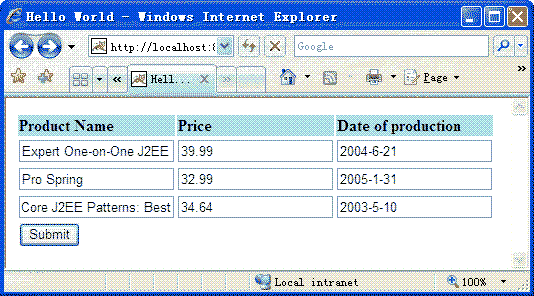Posted on 2012-02-20 21:47
LaozhonG 阅读(543)
评论(1) 编辑 收藏 所属分类:
技术

不知道大家是否遇过这种情况,在一个页面里同时提交几个对象。例如,在发布产品的页面,同时发布几个产品。
首先,在源代码文件夹下的tutorial包中新建Product.java文件,内容如下:
1 package tutorial;
2
3 import java.util.Date;
4
5 publicclass Product {
6 private String name;
7 privatedouble price;
8 private Date dateOfProduction;
9
10 public Date getDateOfProduction() {
11 return dateOfProduction;
12 }
13
14 publicvoid setDateOfProduction(Date dateOfProduction) {
15 this.dateOfProduction = dateOfProduction;
16 }
17
18 public String getName() {
19 return name;
20 }
21
22 publicvoid setName(String name) {
23 this.name = name;
24 }
25
26 publicdouble getPrice() {
27 return price;
28 }
29
30 publicvoid setPrice(double price) {
31 this.price = price;
32 }
33 }
然后,在同上的包下添加ProductConfirm.java类,代码如下:
1 package tutorial;
2
3 import java.util.List;
4
5 import com.opensymphony.xwork2.ActionSupport;
6
7 publicclass ProductConfirm extends ActionSupport {
8 public List<Product> products;
9
10 public List<Product> getProducts() {
11 return products;
12 }
13
14 publicvoid setProducts(List<Product> products) {
15 this.products = products;
16 }
17
18 @Override
19 public String execute() {
20 for(Product p : products) {
21 System.out.println(p.getName() + " | "+ p.getPrice() +" | " + p.getDateOfProduction());
22 }
23 return SUCCESS;
24 }
25 }
接看,在同上的包中加入ProductConfirm-conversion.properties,代码如下:
1 Element_products=tutorial.Product
再在struts.xml文件中配置ProductConfirm Action,代码片段如下:
1 <action name="ProductConfirm" class="tutorial.ProductConfirm">
2 <result>/ShowProducts.jsp</result>
3 </action>
在WEB文件夹下新建AddProducts.jsp,内容如下:
1 <%@ page contentType="text/html; charset=UTF-8"%>
2 <%@taglib prefix="s" uri="/struts-tags"%>
3 <html>
4 <head>
5 <title>Hello World</title>
6 </head>
7 <body>
8 <s:form action="ProductConfirm" theme="simple">
9 <table>
10 <tr style="background-color:powderblue; font-weight:bold;">
11 <td>Product Name</td>
12 <td>Price</td>
13 <td>Date of production</td>
14 </tr>
15 <s:iterator value="new int[3]" status="stat">
16 <tr>
17 <td><s:textfield name="%{'products['+#stat.index+'].name'}"/></td>
18 <td><s:textfield name="%{'products['+#stat.index+'].price'}"/></td>
19 <td><s:textfield name="%{'products['+#stat.index+'].dateOfProduction'}"/></td>
20 </tr>
21 </s:iterator>
22 <tr>
23 <td colspan="3"><s:submit /></td>
24 </tr>
25 </table>
26 </s:form>
27 </body>
28 </html>
在同样的文件夹下创建ShowProducts.jsp,内容如下:
1 <%@ page contentType="text/html; charset=UTF-8"%>
2 <%@taglib prefix="s" uri="/struts-tags"%>
3 <html>
4 <head>
5 <title>Hello World</title>
6 </head>
7 <body>
8 <table>
9 <tr style="background-color:powderblue; font-weight:bold;">
10 <td>Product Name</td>
11 <td>Price</td>
12 <td>Date of production</td>
13 </tr>
14 <s:iterator value="products" status="stat">
15 <tr>
16 <td><s:property value="name"/></td>
17 <td>$<s:property value="price"/></td>
18 <td><s:property value="dateOfProduction"/></td>
19 </tr>
20 </s:iterator>
21 </table>
22 </body>
23 </html>
发布运行应用程序,在浏览器中键入http://localhost:8080/Struts2_Converter/AddProducts.jsp,出现如图4所示页面:
 图4 添加产品页面
按图4所示,填写表单,按“Submit”提交,出现图5所示页面:
图4 添加产品页面
按图4所示,填写表单,按“Submit”提交,出现图5所示页面:
 图5 查看产品页面
查看服务器的控制台,有如下输出:
图5 查看产品页面
查看服务器的控制台,有如下输出:
Expert One-on-One J2EE Development without EJB | 39.99 | Mon Jun 2100:00:00 CST 2004
Pro Spring | 32.99 | Mon Jan 3100:00:00 CST 2005
Core J2EE Patterns: Best Practices and Design Strategies, Second Edition | 34.64 | Sat May 1000:00:00 CST 2003
上面的代码并不复杂,但有几点需要说明:
- ProductConfirm文件中的for(Product p : productes)的写法是J2SE 5.0中的新特性,作用遍历products列表;
- List<Product>也是J2SE 5.0的才有的泛型(Generic);
- ProductConfirm-conversion.properties中“Element_products=tutorial.Product”是告诉Struts 2.0列表products的元素的类型为Product,而不是定义转换器;
- 在AddProducts.jsp的<s:textfield>的name为“%{'products['+#stat.index+'].name'}”,%{exp}格式表示使用OGNL表达式,上述表达式的相当于<%= "products[" + stat.index + "].name" %>,至于<s:iterator>标志的用法可以参考原文主人博客的文章《常用的Struts 2.0的标志(Tag)介绍》。
转换错误处理
不知道大家在运行上面的例子时,有没有填错日期或数字情况,又或者您有没有思考过这种情况?如果还没有尝试的朋友可以试一下,在第一行的Price和Date of production中输入英文字母,然后按“Submit”提交。你会看到页面为空白,再看一下服务器的控制台输出,有如下语句: 警告: No result defined for action tutorial.ProductConfirm and result input,它提示我们没有为Action定义输入结果,所以,我们应该在源代码文件夹下的struts.xml中的ProductConfirm Action中加入以下代码:
1 <result name="input">/AddProducts.jsp</result>
重新加载应用程序,刷新浏览器重新提交请求,这时页面返回AddProducts.jsp,格式错误的输入框的值被保留,如下图6所示:  图6 没有提示的错返回页面
图6 没有提示的错返回页面
当然,我们还可以在页面上加上错误提示信息,通过在AddProducts.jsp的“<body>”后,加入下面代码可以实现: <div style="color:red">
<s:fielderror />
</div> 刷新浏览器,重新提交请求,出现如图7所示页面:  图7 带提示的错返回页面 以上的功能的都是通过Struts 2.0里的一个名为conversionError的拦截器(interceptor)工作,它被注册到默认拦截器栈(default interceptor stack)中。Struts 2.0在转换出错后,会将错误放到ActionContext中,在conversionError的作用是将这些错误封装为对应的项错误(field error),因此我们可以通过<s:fielderror />来将其在页面上显示出来。另外,大家看第二和第三行的Price都被赋为0.0的值,而第一行则保留其错误值。这同样是conversionError的功劳——没有出错的行调用的products[index].price(默认值为0.0),而出错的行则会被赋为页面所提交的错误值,这样可以提供更好的用户体验。
图7 带提示的错返回页面 以上的功能的都是通过Struts 2.0里的一个名为conversionError的拦截器(interceptor)工作,它被注册到默认拦截器栈(default interceptor stack)中。Struts 2.0在转换出错后,会将错误放到ActionContext中,在conversionError的作用是将这些错误封装为对应的项错误(field error),因此我们可以通过<s:fielderror />来将其在页面上显示出来。另外,大家看第二和第三行的Price都被赋为0.0的值,而第一行则保留其错误值。这同样是conversionError的功劳——没有出错的行调用的products[index].price(默认值为0.0),而出错的行则会被赋为页面所提交的错误值,这样可以提供更好的用户体验。 上文中,还需要编写一个转换器,用于格式化日期输入输出!
本文转自Max,更加详细请看原文《
转换器(Converter)——Struts 2.0中的魔术师》
------------------------------------------------------
About Me's
------一个喜欢在一块青石阶上独立行走的人